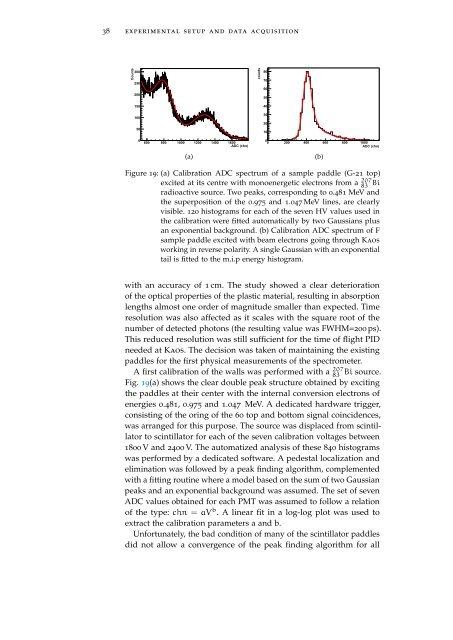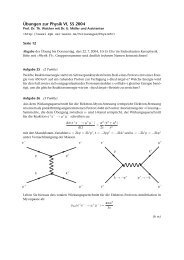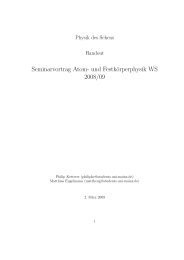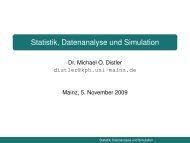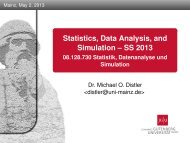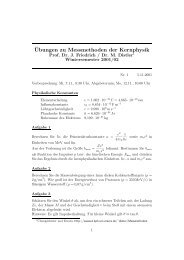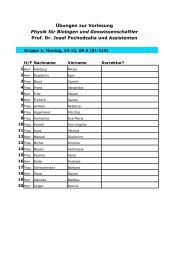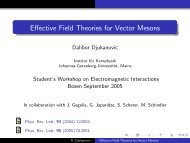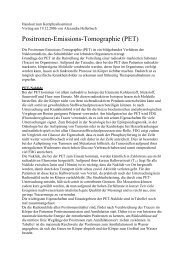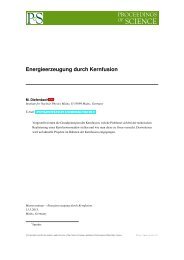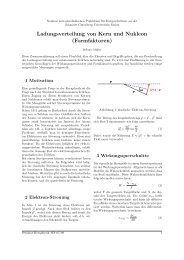A Classic Thesis Style - Johannes Gutenberg-Universität Mainz
A Classic Thesis Style - Johannes Gutenberg-Universität Mainz
A Classic Thesis Style - Johannes Gutenberg-Universität Mainz
You also want an ePaper? Increase the reach of your titles
YUMPU automatically turns print PDFs into web optimized ePapers that Google loves.
38 experimental setup and data acquisition<br />
Counts<br />
300<br />
250<br />
200<br />
150<br />
100<br />
50<br />
0<br />
600 800 1000 1200 1400 1600<br />
ADC (chn)<br />
(a)<br />
counts<br />
80<br />
70<br />
60<br />
50<br />
40<br />
30<br />
20<br />
10<br />
0<br />
0 200 400 600 800 1000<br />
ADC (chn)<br />
Figure 19: (a) Calibration ADC spectrum of a sample paddle (G-21 top)<br />
excited at its centre with monoenergetic electrons from a 207<br />
83 Bi<br />
radioactive source. Two peaks, corresponding to 0.481 MeV and<br />
the superposition of the 0.975 and 1.047 MeV lines, are clearly<br />
visible. 120 histograms for each of the seven HV values used in<br />
the calibration were fitted automatically by two Gaussians plus<br />
an exponential background. (b) Calibration ADC spectrum of F<br />
sample paddle excited with beam electrons going through Kaos<br />
working in reverse polarity. A single Gaussian with an exponential<br />
tail is fitted to the m.i.p energy histogram.<br />
with an accuracy of 1 cm. The study showed a clear deterioration<br />
of the optical properties of the plastic material, resulting in absorption<br />
lengths almost one order of magnitude smaller than expected. Time<br />
resolution was also affected as it scales with the square root of the<br />
number of detected photons (the resulting value was FWHM=200 ps).<br />
This reduced resolution was still sufficient for the time of flight PID<br />
needed at Kaos. The decision was taken of maintaining the existing<br />
paddles for the first physical measurements of the spectrometer.<br />
A first calibration of the walls was performed with a 207<br />
83<br />
(b)<br />
Bi source.<br />
Fig. 19(a) shows the clear double peak structure obtained by exciting<br />
the paddles at their center with the internal conversion electrons of<br />
energies 0.481, 0.975 and 1.047 MeV. A dedicated hardware trigger,<br />
consisting of the oring of the 60 top and bottom signal coincidences,<br />
was arranged for this purpose. The source was displaced from scintillator<br />
to scintillator for each of the seven calibration voltages between<br />
1800 V and 2400 V. The automatized analysis of these 840 histograms<br />
was performed by a dedicated software. A pedestal localization and<br />
elimination was followed by a peak finding algorithm, complemented<br />
with a fitting routine where a model based on the sum of two Gaussian<br />
peaks and an exponential background was assumed. The set of seven<br />
ADC values obtained for each PMT was assumed to follow a relation<br />
of the type: chn = aV b . A linear fit in a log-log plot was used to<br />
extract the calibration parameters a and b.<br />
Unfortunately, the bad condition of many of the scintillator paddles<br />
did not allow a convergence of the peak finding algorithm for all


